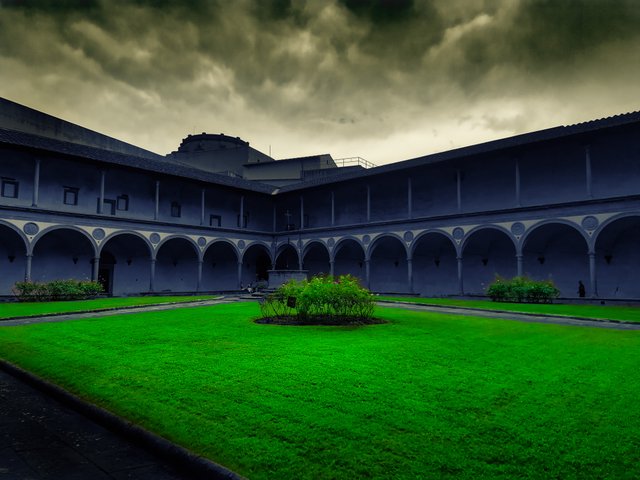📷Firenze
🏰The Palazzo Vecchio – The Piazza della Signoria
“Ecco il Palagio de' Signori si bello
che chi cercasse tutto l'universo,
non credo ch'e trovasse par di quello.”
— Antonio Pucci
The Heart of Florence
At the eastern corner of the Piazza della Signoria—that great square over which almost all the history of Florence may be said to have passed—rises the Palazzo Vecchio, with its great projecting parapets and soaring tower: the old Palace of the Signoria, originally the Palace of the Priors, and therefore of the People.
It is often stated that the square battlements of the Palace represent the Guelfs, while the forked battlements of the tower are connected with the Ghibellines. However, there is no historical foundation for this legend.
🧱 Arnolfo di Cambio and the People's Palace
The Palace was begun by Arnolfo di Cambio in 1298, when the Priors were thought to be unsafe in the Palace of the Cerchi due to tensions between the magnates and the people. The Palazzo Vecchio thus mirrors the course of Florentine history, from the government of the Secondo Popolo, through Savonarola’s Republic and the Medicean despotism, down to the unification of Italy.
Arnolfo founded the tower of the Priors on an older tower of the Foraboschi, called the Torre della Vacca (“Tower of the Cow”). When its great bell rang to summon a parliament or call the city to arms, it was said “the cow was lowing.” 🐮
The upper part of the tower belongs to the fifteenth century.
The Palazzo could have been larger—but Arnolfo was forbidden to build upon the ruins of the Uberti family, rebels and Ghibellines.
Even the heroism of Farinata degli Uberti could not soften this city's fierce republican laws.
⚖️ The Ringhiera and the Steps of Power
The present steps and platform in front of the Palace are remnants of the Ringhiera (14th century, removed in 1812).
Here the Signoria addressed the people, entered office, and gave batons of command to condottieri (mercenary leaders).
Here the Duke of Athens was acclaimed Signore a vita—and later, his own followers threw his agents to the mob.
Over the door:
The monogram of Christ (added in 1528 by Gonfaloniere Niccolò Capponi) once declared:
“Jesus Christ, King of the Florentine People” — later modified by Cosimo I.
🏛️ Art and Atrocity at the Entrance
- Right: Hercules and Cacus by Baccio Bandinelli – considered an atrocity.
Benvenuto Cellini recounts a fiery argument about it with Bandinelli in the Duke’s presence. - Left: Marzocco, the lion of Florence — a copy after Donatello.
🌿 The Courtyard of Michelozzo
The court, begun by Michelozzo in 1434, features stucco ornamentation and frescoes painted for the marriage of Francesco de’ Medici and Giovanna of Austria (1565).
In the centre stands Andrea Verrocchio’s bronze boy with a dolphin, made for Lorenzo the Magnificent.
“The little boy who forever half runs and half flits across the courtyard, while the dolphin ceaselessly struggles in his arms.”
— Mr. Armstrong, in Lorenzo de’ Medici
🎨 The Hall of the Five Hundred (Salone dei Cinquecento)
Constructed in 1495 by Simone del Pollaiuolo (nicknamed Cronaca), this vast hall was the meeting place of the Greater Council, which Savonarola proclaimed to be “the work of God and not of man.”
Here he preached his passionate sermon (August 20, 1496):
“I want no hats, no mitres great or small;
nought would I have save what Thou hast given to Thy saints — death;
a red hat, a hat of blood — this do I desire.”
🎭 Leonardo & Michelangelo: La Scuola del Mondo
In 1503, Leonardo da Vinci and Michelangelo were commissioned to decorate the walls.
Their lost cartoons — The Battle of the Standard (Leonardo) and Soldiers Bathing in the Arno (Michelangelo) — were hailed as the supreme works of the Renaissance.
Sadly, no original traces remain.
Copies and engravings hint at what the world lost.
🙏 The Sala dei Gigli and the Priors’ Chapel
The Sala dei Gigli (Hall of Lilies) contains frescoes by Domenico Ghirlandaio (c. 1482), showing St. Zenobius enthroned, with Roman heroes and a beautiful Madonna and Child in bas-relief style.
Nearby lies the Priors’ Chapel, where Savonarola said his final Mass before execution, praying:
“Lord, I know that Thou art that very God,
the Creator of the world and of human nature…
May Thy precious Blood not be shed for me in vain,
but for the remission of all my sins. Amen.”
👑 The Apartments of Eleonora of Toledo
Beyond the chapel are the chambers of Duchess Eleonora, wife of Duke Cosimo I, with a chapel by Bronzino.
Here she famously scolded Benvenuto Cellini, who was fond of bursting in unannounced to speak with the Duke.
⛓️ The Alberghettino: Prison of the Great
A small cell discovered in 1814 is believed to be where Cosimo the Elder was imprisoned in 1433, and later Savonarola before his execution.
Here he wrote his Meditations on the “In te Domine Speravi” and the Miserere — read across Christendom.
🌊 Neptune and Cosimo: Symbols of Power
Outside stands the fountain of Neptune by Bartolommeo Ammanati, symbolizing Medicean control of the seas, and the bronze equestrian statue of Cosimo I by Giambologna (1594), the first Grand Duke of Tuscany.
The tyrant sits sternly, guarding the Piazza where he extinguished the last sparks of liberty.
⚔️ The Loggia dei Lanzi: Stage of Glory and Tragedy
Originally built (1376) by Benci di Cione and Simone Talenti, this open vaulted hall served as the throne of the Republic — where magistrates performed public functions.
Beneath its arches now stand masterpieces:
- Donatello’s Judith and Holofernes
- Cellini’s Perseus with the Head of Medusa (1553)
“The crowd gazed upon me as a miracle,” Cellini boasts, “for having accomplished such a work.”
🔥 The Ordeal of Fire (Cimento di Fuoco) – April 7, 1498
Here, in this Loggia, took place one of the most dramatic scenes of Florence’s history:
the trial by fire between Savonarola’s Dominicans and the Franciscans of Santa Croce.
An immense crowd filled the Piazza.
The Compagnacci — the Friar’s enemies — waited armed under the Tetto dei Pisani.
The Dominicans marched in singing the Exsurgat Deus.
Savonarola entered with the Blessed Sacrament.
Delay followed delay — suspicion of magic, storms, wrangling — until, at sunset, the ordeal was cancelled.
The mob erupted. Savonarola barely escaped alive.
“As Fra Girolamo issued from the Loggia with the Sacrament in his hands,” writes chronicler Simone Filipepi,
“the signal was given to kill him — but by God’s will, Doffo Spini did nothing.”
💔 Aftermath and Memory
Doffo Spini later confessed to Simone that, had he known Savonarola earlier,
“I would have been a more ardent partisan of his than even Simone, for nothing save good was ever seen in him unto his death.”
Florence’s Piazza della Signoria remains an open-air chronicle of the city’s glory, genius, and blood — where faith, art, and power once stood face to face.
| Category | #photography |
| Photo taken at | Florence - Italy |
)


Upvoted! Thank you for supporting witness @jswit.